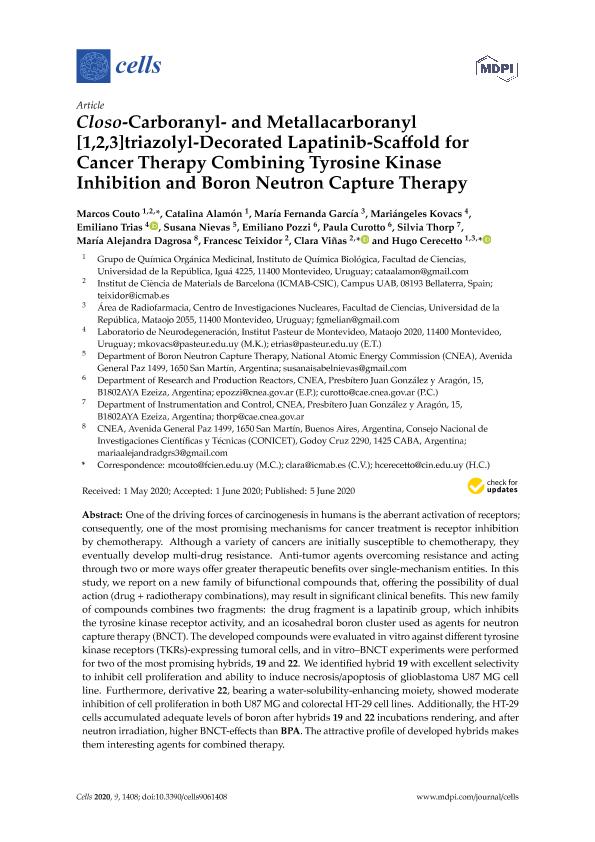Mostrar el registro sencillo del ítem
dc.contributor.author
Couto, Marcos
dc.contributor.author
Alamón, Catalina
dc.contributor.author
García, María
dc.contributor.author
Kovacs, Mariángeles
dc.contributor.author
Trias, Emiliano
dc.contributor.author
Nievas, Susana Isabel

dc.contributor.author
Pozzi, Emiliano César Cayetano

dc.contributor.author
Curotto, Paula

dc.contributor.author
Thorp, Silvia Inés

dc.contributor.author
Dagrosa, María Alejandra

dc.contributor.author
Teixidor, Francesc
dc.contributor.author
Viñas, Clara
dc.contributor.author
Cerecetto, Hugo
dc.date.available
2022-09-16T13:25:25Z
dc.date.issued
2020-06
dc.identifier.citation
Couto, Marcos; Alamón, Catalina; García, María; Kovacs, Mariángeles; Trias, Emiliano; et al.; Closo-Carboranyl- and Metallacarboranyl [1,2,3]triazolyl-Decorated Lapatinib-Scaffold for Cancer Therapy Combining Tyrosine Kinase Inhibition and Boron Neutron Capture Therapy; MPDI; Cells; 9; 6; 6-2020; 1-18
dc.identifier.issn
2073-4409
dc.identifier.uri
http://hdl.handle.net/11336/169051
dc.description.abstract
One of the driving forces of carcinogenesis in humans is the aberrant activation of receptors; consequently, one of the most promising mechanisms for cancer treatment is receptor inhibition by chemotherapy. Although a variety of cancers are initially susceptible to chemotherapy, they eventually develop multi-drug resistance. Anti-tumor agents overcoming resistance and acting through two or more ways offer greater therapeutic benefits over single-mechanism entities. In this study, we report on a new family of bifunctional compounds that, offering the possibility of dual action (drug + radiotherapy combinations), may result in significant clinical benefits. This new family of compounds combines two fragments: the drug fragment is a lapatinib group, which inhibits the tyrosine kinase receptor activity, and an icosahedral boron cluster used as agents for neutron capture therapy (BNCT). The developed compounds were evaluated in vitro against different tyrosine kinase receptors (TKRs)-expressing tumoral cells, and in vitro-BNCT experiments were performed for two of the most promising hybrids, 19 and 22. We identified hybrid 19 with excellent selectivity to inhibit cell proliferation and ability to induce necrosis/apoptosis of glioblastoma U87 MG cell line. Furthermore, derivative 22, bearing a water-solubility-enhancing moiety, showed moderate inhibition of cell proliferation in both U87 MG and colorectal HT-29 cell lines. Additionally, the HT-29 cells accumulated adequate levels of boron after hybrids 19 and 22 incubations rendering, and after neutron irradiation, higher BNCT-effects than BPA. The attractive profile of developed hybrids makes them interesting agents for combined therapy.
dc.format
application/pdf
dc.language.iso
eng
dc.publisher
MPDI
dc.rights
info:eu-repo/semantics/openAccess
dc.rights.uri
https://creativecommons.org/licenses/by/2.5/ar/
dc.subject
BORON CLUSTERS
dc.subject
IN VITRO BNCT EFFECT
dc.subject
LAPATINIB
dc.subject
TYROSINE KINASE INHIBITORS
dc.subject
[1,2,3]TRIAZOLYL LINKER
dc.subject.classification
Otras Medicina Básica

dc.subject.classification
Medicina Básica

dc.subject.classification
CIENCIAS MÉDICAS Y DE LA SALUD

dc.title
Closo-Carboranyl- and Metallacarboranyl [1,2,3]triazolyl-Decorated Lapatinib-Scaffold for Cancer Therapy Combining Tyrosine Kinase Inhibition and Boron Neutron Capture Therapy
dc.type
info:eu-repo/semantics/article
dc.type
info:ar-repo/semantics/artículo
dc.type
info:eu-repo/semantics/publishedVersion
dc.date.updated
2022-09-15T14:58:19Z
dc.journal.volume
9
dc.journal.number
6
dc.journal.pagination
1-18
dc.journal.pais
Estados Unidos

dc.description.fil
Fil: Couto, Marcos. Universidad de la República; Uruguay
dc.description.fil
Fil: Alamón, Catalina. Universidad de la República. Facultad de Ciencias; Uruguay
dc.description.fil
Fil: García, María. Universidad de la República. Facultad de Ciencias; Uruguay
dc.description.fil
Fil: Kovacs, Mariángeles. Instituto Pasteur; Francia
dc.description.fil
Fil: Trias, Emiliano. Instituto Pasteur; Francia
dc.description.fil
Fil: Nievas, Susana Isabel. Comisión Nacional de Energía Atómica; Argentina
dc.description.fil
Fil: Pozzi, Emiliano César Cayetano. Comisión Nacional de Energía Atómica; Argentina
dc.description.fil
Fil: Curotto, Paula. Comisión Nacional de Energía Atómica; Argentina
dc.description.fil
Fil: Thorp, Silvia Inés. Comisión Nacional de Energía Atómica; Argentina
dc.description.fil
Fil: Dagrosa, María Alejandra. Comisión Nacional de Energía Atómica; Argentina. Consejo Nacional de Investigaciones Científicas y Técnicas; Argentina
dc.description.fil
Fil: Teixidor, Francesc. Consejo Superior de Investigaciones Científicas; España
dc.description.fil
Fil: Viñas, Clara. Consejo Superior de Investigaciones Científicas; España
dc.description.fil
Fil: Cerecetto, Hugo. Universidad de la República. Facultad de Química. Departamento de Química Orgánica; Uruguay
dc.journal.title
Cells
dc.relation.alternativeid
info:eu-repo/semantics/altIdentifier/url/https://www.mdpi.com/2073-4409/9/6/1408
dc.relation.alternativeid
info:eu-repo/semantics/altIdentifier/doi/http://dx.doi.org/10.3390/cells9061408
Archivos asociados
